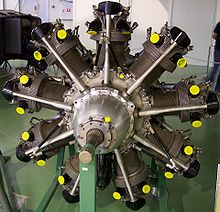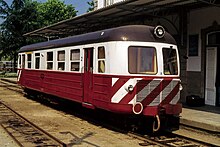Nydqvist and Holm

The Nohab AB (short NOHAB or NoHAB ) was a Swedish metal processing company based in Trollhättan .
history
The company goes back to Trollhättans Mekaniska Verkstad , founded in 1847 by Antenor Nydqvist , Johan Magnus Lidström and Carl Olof Holm , which initially manufactured water turbines for which Nydquist held several patents. With initially nine employees, the first order for the construction of parts for the Trollhätte Canal was secured. The company expanded quickly.
Lidström left the company in 1850. It then renamed Nydqvist och Holm AB . In addition to the turbines, machines for agriculture and steam engines were also manufactured, which were used in locomotives and locomobiles . In 1865 the first own locomotive was built. In 1867, Holm also left the company. In 1906 Herman Nydqvist , the son of the company founder, took over the company. In 1912 the 1000th locomotive was delivered. Nydquist ran the company alone until 1916, when Svenska Kullagerfabriken (SKF) joined the company. In 1920 it was possible to secure an order from the Soviet Union for 1,000 locomotives of the Э ш series . The order was later reduced to 500. At this point in time, the company had 2641 employees. As there was no follow-up order, the company temporarily ran into economic difficulties. The production of diesel engines also began in 1926 . In 1927 only 395 people were employed.
In the early 1930s, the subsidiary NOHAB Flygmotorfabrik AB was founded, which acquired license rights from the Bristol Aircraft Company for the production of Bristol Jupiter and Bristol Mercury aircraft engines . Production began in 1933. In 1937 this subsidiary became part of Saab before being bought by Volvo and Bofors in 1941 and renamed Svenska Flygmotor AB .
In 1935, NOHAB started a collaboration with Bofors. They started with the production of tractors and buses. With the beginning of the Second World War , production was switched to armaments.
The last steam locomotive left the factory in 1953. By then, 2,300 steam and electric locomotives had already been manufactured in Trollhättan. After the end of the war, NOHAB acquired the diesel engine branch from Atlas and in 1949 was able to agree with General Motors to license the production of the AA16 locomotive , a version for Europe of the US standard EMD-F series . This type was initially intended for Denmark, was produced in the 1950s and 1960s and initially exported to Denmark, but later also to Norway and Hungary, among others.
The production range was expanded to include the Stridsvagn 103 tank from 1966 . The company also started manufacturing forklifts , cranes and printing machines . Together with ASEA , it participated in the production of the Swedish nuclear power plants .
In the mid-1970s, renewed economic difficulties emerged. The core business of locomotive construction declined sharply. 1978 Wärtsilä took over 51% of the shares. In 1979 the last locomotives of the Statens-Järnvägar Rc series left the factory and the branches of the business began to sell individually. Wartsilä founded the new company NOHAB Diesel AB in 1979 . The printing machines were built by GMA-NOHAB Printing AB from 1981 . The turbine production went to Aker Kvaerner . From then on, Kalmar NOHAB AB manufactured accessories for rail vehicles . Other small business areas were taken over by former employees in a management buyout .
Today only NOHAB Industri AB exists of the group , which carries out metal processing.
See also
Web links
Individual evidence
- ↑ Round noses in: Lok Magazin 1/2016, p. 61 ff.
- ^ Erik Sundström, Rolf Sten: Ånglok tillverkade av Nydqvist & Holm. In: historiskt.nu. October 17, 2007, accessed May 24, 2019 (Swedish).


